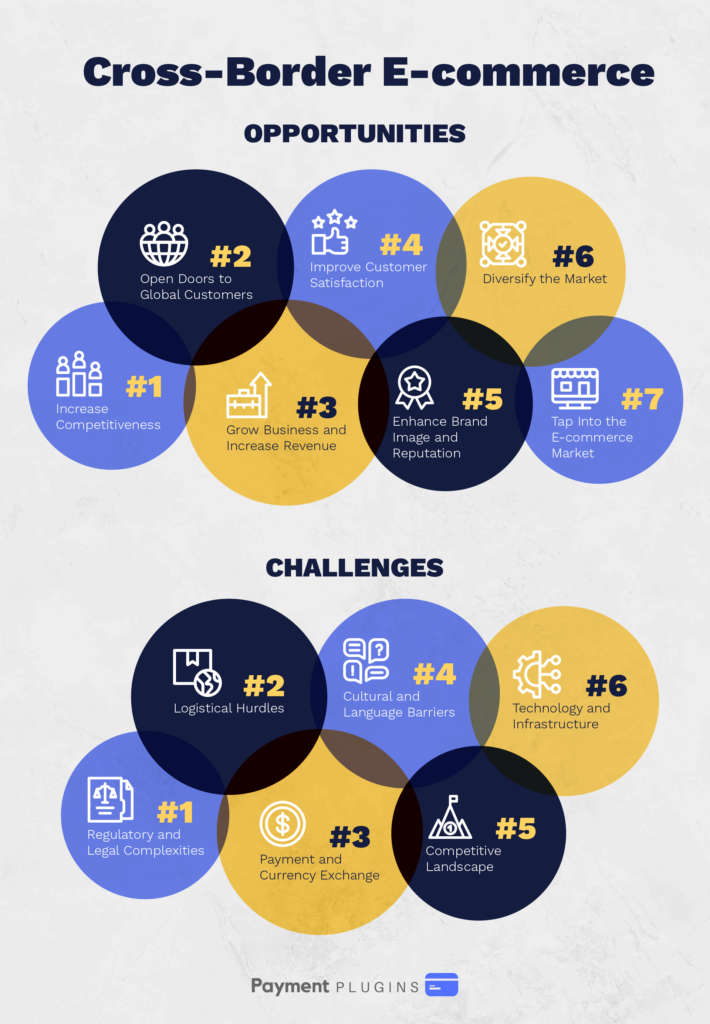
In an increasingly interconnected world, cross-border e-commerce has emerged as a transformative force in the global marketplace. The rapid growth of online shopping and advancements in logistics and technology have opened up new avenues for businesses to engage in international trade and tap into lucrative consumer markets across borders.
However, along with its vast potential for expansion and profit, cross-border e-commerce also presents a unique set of challenges that must be navigated by businesses seeking to thrive in this dynamic environment. From regulatory complexities and cultural barriers to logistical hurdles and fierce competition, the journey of cross-border e-commerce is a nuanced one.
We will explore the challenges and opportunities associated with cross-border e-commerce and shed light on the key factors that businesses must consider to succeed in this ever-evolving landscape.

Share this Image On Your Site
copy and paste the following code to your site
Opportunities
Here are the opportunities associated with cross-border e-commerce.
#1: Increase Competitiveness
Accepting international payments can make businesses more competitive in their market. In an era where globalization is the norm, businesses that do not offer the option to accept international payments are limiting their growth potential. By embracing international payment methods (such as Stripe, Braintree, and PayPal), a business stands out from its competitors and earns a reputation for being forward-thinking and attentive to customers’ needs.
#2: Open Doors to Global Customers
One of the primary advantages of accepting international payments is that it opens doors to global customers. With international payment options in place, businesses can easily cater to customers from around the world. This increased accessibility and convenience encourages global customers to make repeat purchases and results in enhanced customer experience.
#3: Grow Business and Increase Revenue
Seamless international payment options enable businesses to cater to a larger international customer base and lead to a significant increase in revenue. By offering international payment options, a business can tap into untapped markets around the world, expand its reach, and boost its revenue streams.
#4: Improve Customer Satisfaction

Limited payment options often frustrate customers, particularly when it comes to international transactions. By providing international payment options, businesses offer customers the convenience of familiar payment methods and increase overall satisfaction with the seamless payment process. This, in turn, reduces frustrations associated with international payments and strengthens the company’s reputation as a customer-centric brand.
#5: Enhance Brand Image and Reputation
Accepting international payments allows businesses to enhance their brand image and reputation on a global scale. It demonstrates a commitment to serving international customers and showcases an infrastructure capable of supporting a growing number of international transactions. Such a reputation can attract more customers, drive customer loyalty, and boost the brand’s standing in the market.
#6: Diversify the Market
Accepting international payments enables businesses to diversify their market and reduce dependency on a single domestic market. Economic conditions fluctuate across different countries, and relying solely on the domestic market for revenue carries inherent risks. By having customers in different countries, businesses can mitigate the risk of revenue loss during economic downturns in a single market and ensure a more stable and sustainable growth trajectory.
#7: Tap Into the E-commerce Market
E-commerce has experienced tremendous growth worldwide, and businesses familiar with domestic e-commerce have the potential to expand further by tapping into e-commerce in other countries. By identifying countries with emerging online shopping trends, businesses can seize the opportunity for expansion and increased sales. Accepting international payments is the gateway to tapping into this lucrative e-commerce market.
Challenges

Here are the challenges associated with cross-border e-commerce.
#1: Regulatory and Legal Complexities
Cross-border e-commerce operates within a complex web of regulations, custom procedures, and legal frameworks that vary across different countries. Navigating these intricate systems can be a daunting task for businesses. Compliance with import and export regulations, tax obligations, consumer protection laws, and data privacy regulations can pose significant challenges. Additionally, cultural and linguistic differences further complicate the process and require businesses to invest time and resources in understanding and adhering to each market’s specific requirements.
#2: Logistical Hurdles
Efficient logistics is crucial for successful cross-border e-commerce, but it presents unique challenges. Shipping items, custom clearance procedures, and the management of international supply chains can be complex and time-consuming. Dealing with multiple transportation providers, coordinating inventory across different locations, and ensuring prompt delivery to customers can be challenging.
#3: Payment and Currency Exchange
The diversity of currencies and payment systems around the world poses challenges. Accepting international payments securely, offering various payment methods preferred by customers in different markets, and managing various payment methods can mitigate those challenges. Currency fluctuations and associated costs may impact pricing.
#4: Cultural and Language Barriers
Cross-border e-commerce demands a deep understanding of cultural nuances and effective communication with customers from diverse backgrounds. Language barriers can hinder customer support and marketing efforts. Cultural differences in shopping preferences, payment methods, and consumer behavior also influence strategies and necessitate localization efforts. Adapting marketing messages and customer service to resonate with the target audience is essential.
#5: Competitive Landscape
Entering foreign markets means facing fierce competition from both local and international players. Gaining visibility and capturing market share requires businesses to differentiate themselves, offer unique value propositions, and tailor their strategies to cater to local preferences. Staying ahead in a competitive landscape often calls for market research, product localization, strategic partnerships, and targeting marketing campaigns.
#6: Technology and Infrastructure
Cross-border e-commerce relies heavily on robust technological infrastructure to facilitate transactions, ensure secure payments, manage inventory, and streamline logistics. However technological disparities across regions can pose challenges. Businesses must carefully assess and adapt their technological capabilities to ensure a seamless and reliable cross-border e-commerce operation.
Increase Your Opportunities With Payment Plugins

At Payment Plugins, we understand the importance of seamless international payment options. Our advanced fraud detection, quick and easy setup, and subscription support make it easier than ever for businesses to embrace international payments.
Increase your company’s competitiveness and unlock global opportunities by utilizing our payment plugins today!
